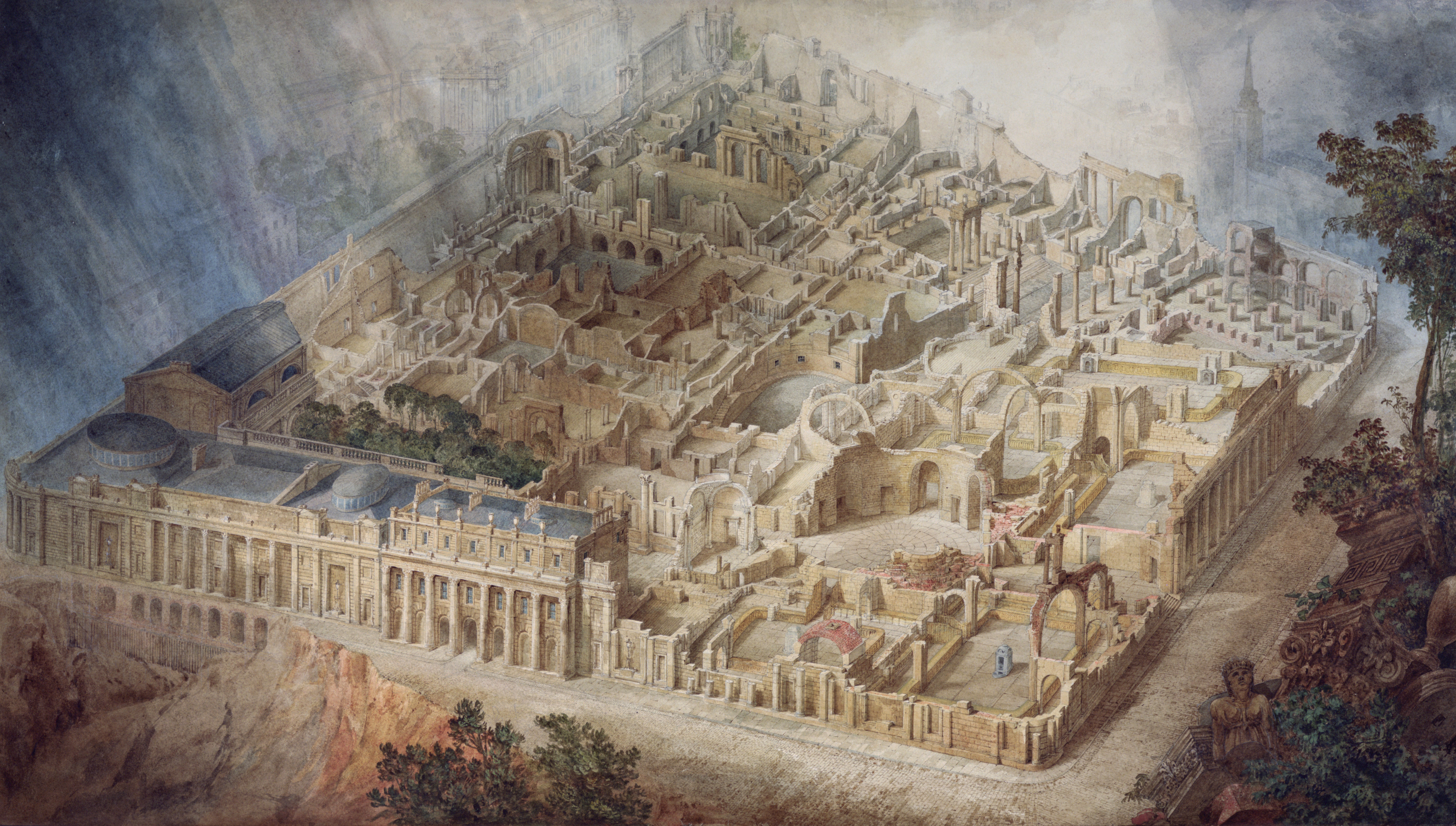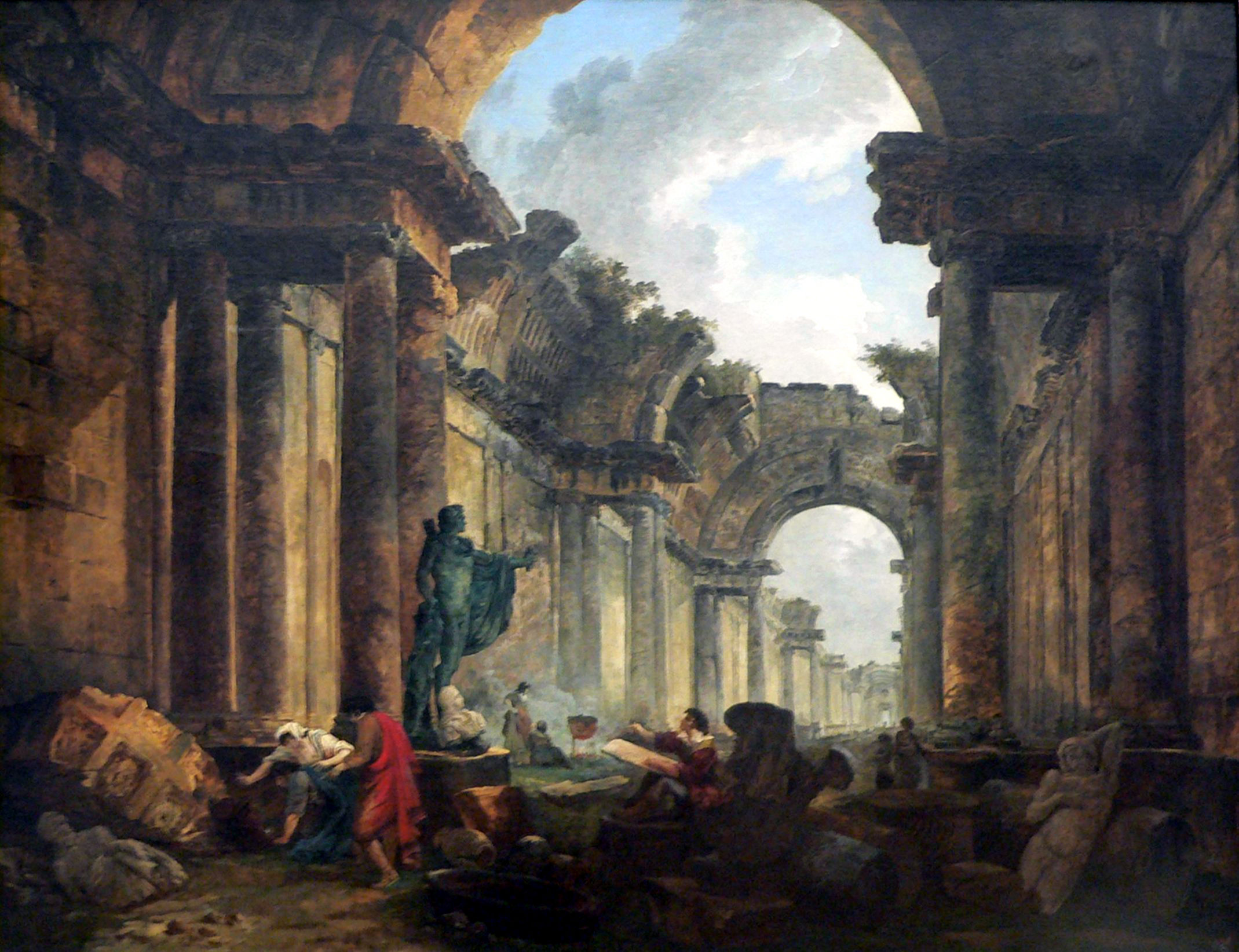Ruin value on:
[Wikipedia]
[Google]
[Amazon]
Ruin value (german: Ruinenwert) is the concept that a

 In his memoirs, Albert Speer claimed to have invented the idea, which he referred to as the theory of Ruin Value ( Gr. ''Ruinenwerttheorie''). It was supposedly an extension of Gottfried Semper's views about using "natural" materials and the avoidance of iron girders. In reality it was a much older concept, even becoming a Europe-wide Romantic fascination at one point. Predecessors include a "new ruined castle" built by the Landgraf of
In his memoirs, Albert Speer claimed to have invented the idea, which he referred to as the theory of Ruin Value ( Gr. ''Ruinenwerttheorie''). It was supposedly an extension of Gottfried Semper's views about using "natural" materials and the avoidance of iron girders. In reality it was a much older concept, even becoming a Europe-wide Romantic fascination at one point. Predecessors include a "new ruined castle" built by the Landgraf of
building
A building, or edifice, is an enclosed structure with a roof and walls standing more or less permanently in one place, such as a house or factory (although there's also portable buildings). Buildings come in a variety of sizes, shapes, and fu ...
be designed in such a way that if it eventually collapsed, it would leave behind aesthetically pleasing ruins that would last far longer without any maintenance at all. The idea was pioneered by German
German(s) may refer to:
* Germany (of or related to)
** Germania (historical use)
* Germans, citizens of Germany, people of German ancestry, or native speakers of the German language
** For citizens of Germany, see also German nationality law
**Ge ...
architect Albert Speer while planning for the 1936 Summer Olympics and published as "The Theory of Ruin Value" (''Die Ruinenwerttheorie''), although he was not its original inventor. The intention did not stretch only to the eventual collapse of the buildings, but rather assumed such buildings were inherently better designed and more imposing during their period of use.
The idea was supported by Adolf Hitler
Adolf Hitler (; 20 April 188930 April 1945) was an Austrian-born German politician who was dictator of Nazi Germany, Germany from 1933 until Death of Adolf Hitler, his death in 1945. Adolf Hitler's rise to power, He rose to power as the le ...
, who planned for such ruins to be a symbol of the greatness of the Third Reich
Nazi Germany (lit. "National Socialist State"), ' (lit. "Nazi State") for short; also ' (lit. "National Socialist Germany") (officially known as the German Reich from 1933 until 1943, and the Greater German Reich from 1943 to 1945) was ...
, just as Ancient Greek
Ancient Greek includes the forms of the Greek language used in ancient Greece and the ancient world from around 1500 BC to 300 BC. It is often roughly divided into the following periods: Mycenaean Greek (), Dark Ages (), the Archaic p ...
and Roman ruins were symbolic of those civilisations.
Albert Speer

 In his memoirs, Albert Speer claimed to have invented the idea, which he referred to as the theory of Ruin Value ( Gr. ''Ruinenwerttheorie''). It was supposedly an extension of Gottfried Semper's views about using "natural" materials and the avoidance of iron girders. In reality it was a much older concept, even becoming a Europe-wide Romantic fascination at one point. Predecessors include a "new ruined castle" built by the Landgraf of
In his memoirs, Albert Speer claimed to have invented the idea, which he referred to as the theory of Ruin Value ( Gr. ''Ruinenwerttheorie''). It was supposedly an extension of Gottfried Semper's views about using "natural" materials and the avoidance of iron girders. In reality it was a much older concept, even becoming a Europe-wide Romantic fascination at one point. Predecessors include a "new ruined castle" built by the Landgraf of Hesse-Kassel
The Landgraviate of Hesse-Kassel (german: Landgrafschaft Hessen-Kassel), spelled Hesse-Cassel during its entire existence, was a state in the Holy Roman Empire that was directly subject to the Emperor. The state was created in 1567 when the Lan ...
in the 18th century, and the designs for the Bank of England built in the 19th century produced by Sir John Soane
Sir John Soane (; né Soan; 10 September 1753 – 20 January 1837) was an English architect who specialised in the Neoclassical architecture, Neo-Classical style. The son of a bricklayer, he rose to the top of his profession, becoming professo ...
. When he presented the bank's governors with three oil sketches of the planned building one of them depicted it when it would be new, another when it would be weathered, and a third what its ruins would look like a thousand years onward.
Speer's memoirs reveal Hitler's thoughts about Nazi state architecture in relation to Roman imperial architecture:
Hitler accordingly approved Speer's recommendation that, in order to provide a "bridge to tradition" to future generations, modern "anonymous" materials such as steel girders and ferroconcrete
Reinforced concrete (RC), also called reinforced cement concrete (RCC) and ferroconcrete, is a composite material in which concrete's relatively low tensile strength and ductility are compensated for by the inclusion of reinforcement having hig ...
should be avoided in the construction of monumental party buildings wherever possible, since such materials would not produce aesthetically acceptable ruins. Thus, the most politically significant buildings of the Reich were intended, to some extent, even after falling into ruins after thousands of years, to resemble their Roman models.
Speer expressed his views on the matter in the Four Year Plan
The Four Year Plan was a series of economic measures initiated by Adolf Hitler in Nazi Germany in 1936. Hitler placed Hermann Göring in charge of these measures, making him a Reich Plenipotentiary (Reichsbevollmächtigter) whose jurisdiction cut a ...
of 1937 in his contribution ''Stone Not Iron'' in which he published a photograph of the Parthenon
The Parthenon (; grc, Παρθενών, , ; ell, Παρθενώνας, , ) is a former temple on the Athenian Acropolis, Greece, that was dedicated to the goddess Athena during the fifth century BC. Its decorative sculptures are considere ...
with the subscript: "The stone buildings of antiquity demonstrate in their condition today the permanence of natural building materials." Later, after saying modern buildings rarely last more than fifty years, he continues: "The ages-old stone buildings of the Egyptians and the Romans still stand today as powerful architectural proofs of the past of great nations, buildings which are often ruins only because man's lust for destruction has made them such." Hitler approved Speer's "Law of Ruin Value" ( Gr. ''Ruinengesetz'') after Speer had shown him a sketch of the Haupttribüne as an ivy-covered ruin. The drawing pleased Hitler but scandalised his entourage.
However, due to the onset of the Second World War
World War II or the Second World War, often abbreviated as WWII or WW2, was a world war that lasted from 1939 to 1945. It involved the vast majority of the world's countries—including all of the great powers—forming two opposi ...
, Nazi German architecture made extensive use of concrete.
Modern planned ruins
A more modern example of intended ruins were the planned warning signs for the proposed nuclear waste repository atYucca Mountain
Yucca Mountain is a mountain in Nevada, near its border with California, approximately northwest of Las Vegas. Located in the Great Basin, Yucca Mountain is east of the Amargosa Desert, south of the Nevada Test and Training Range and in the ...
(see Human Interference Task Force
The Human Interference Task Force was a team of engineers, anthropologists, nuclear physicists, behavioral scientists and others convened on behalf of the U.S. Department of Energy and Bechtel Corp. to find a way to reduce the likelihood of futu ...
), which were intended to endure for 10,000 years, and yet still convey an enduring (if negative) impression on future generations: "Keep out. Don't dig here."
Architect Charles Jencks
Charles Alexander Jencks (21 June 1939 – 13 October 2019) was an American cultural theorist, landscape designer, architectural historian, and co-founder of the Maggie’s Cancer Care Centres. He published over thirty books and became famous i ...
mentions "Ruins in the Garden", a section of the Neue Staatsgalerie, as a postmodern subversion of ruin value.
See also
*Fascist architecture
Fascist architecture encompasses various stylistic trends in architecture developed by architects of fascist states, primarily in the early 20th century. Fascist architectural styles gained popularity in the late 1920s with the rise of modernism a ...
* Mausoleum
* Memorial
*Nazi architecture
Nazi architecture is the architecture promoted by Adolf Hitler and the Nazi regime from 1933 until its fall in 1945, connected with urban planning in Nazi Germany. It is characterized by three forms: a stripped neoclassicism, typified by the ...
*Time capsule
A time capsule is a historic cache of goods or information, usually intended as a deliberate method of communication with future people, and to help future archaeologists, anthropologists, or historians. The preservation of holy relics dates ...
*Folly
In architecture, a folly is a building constructed primarily for decoration, but suggesting through its appearance some other purpose, or of such extravagant appearance that it transcends the range of usual garden buildings.
Eighteenth-cent ...
References
{{Reflist Building engineering Nazi architecture Ruins